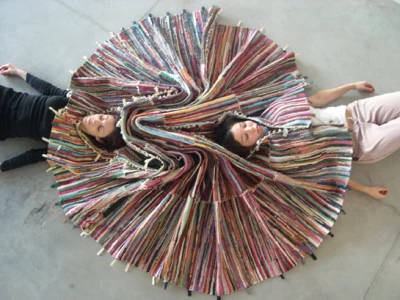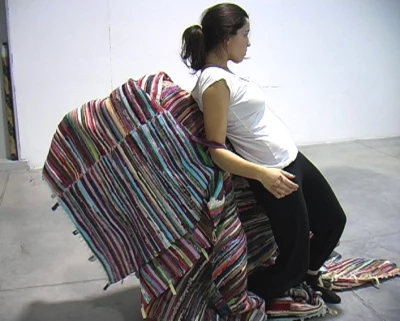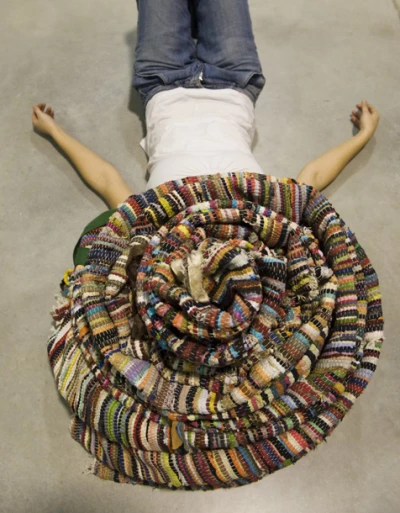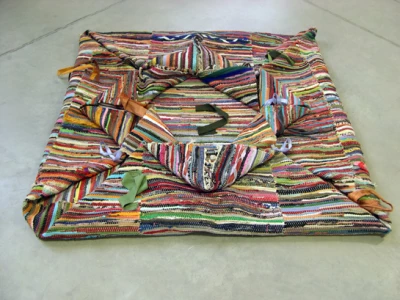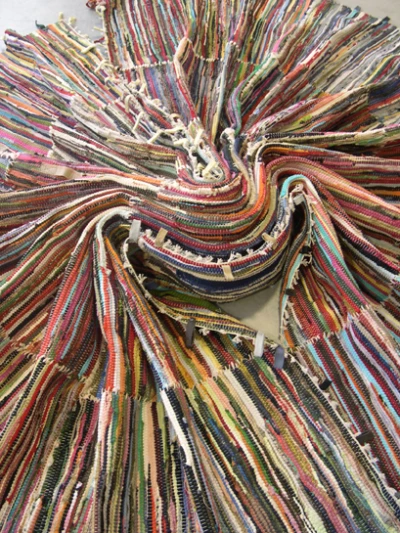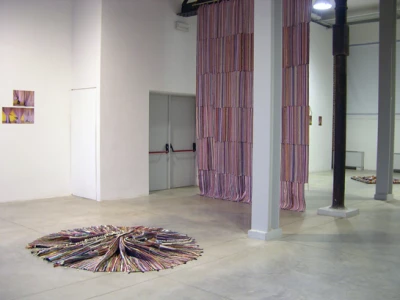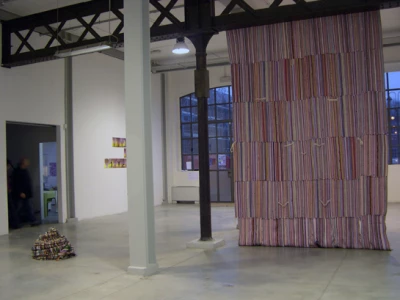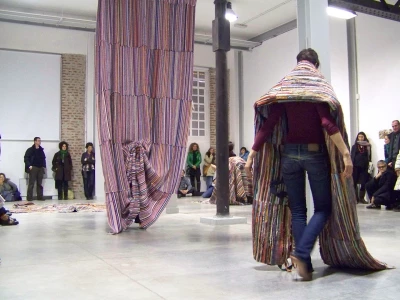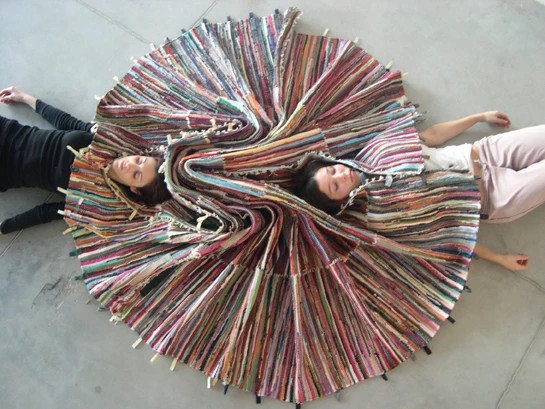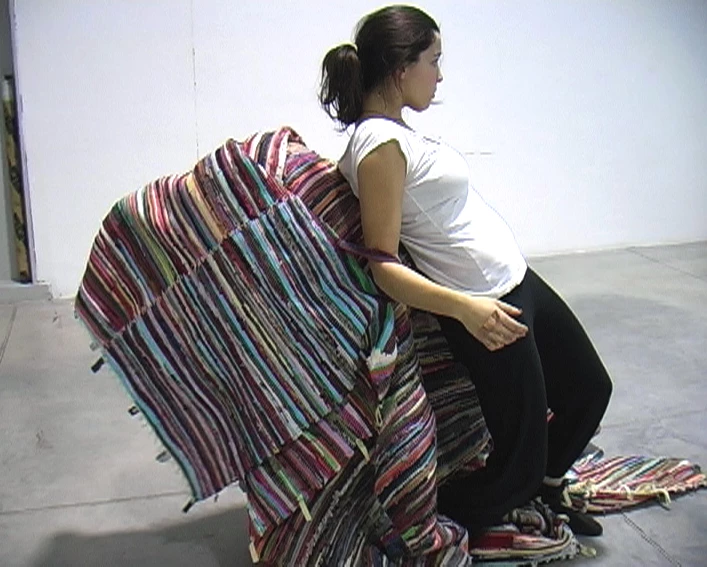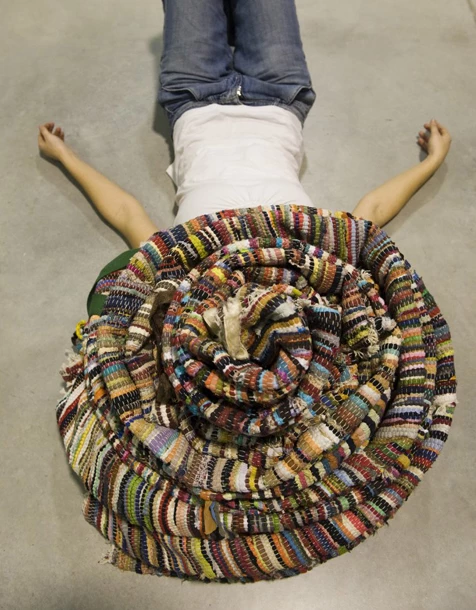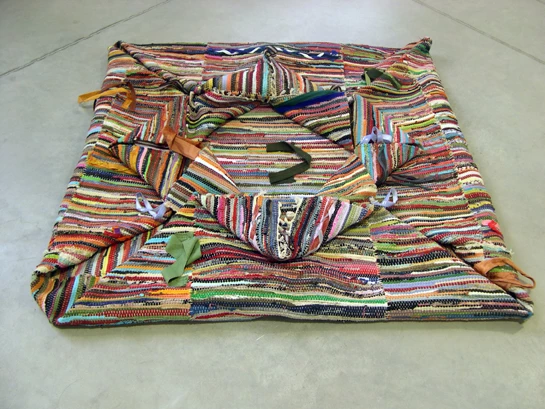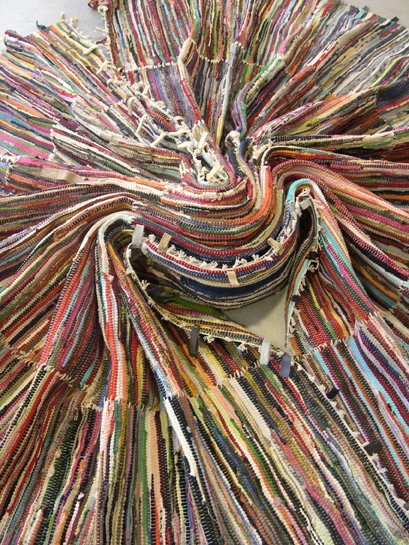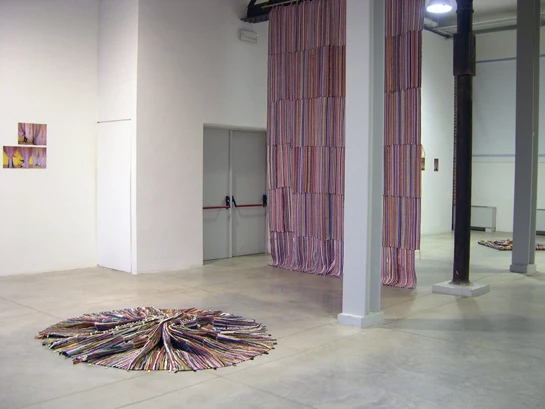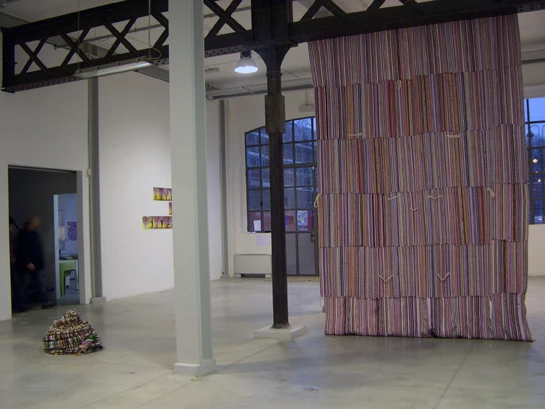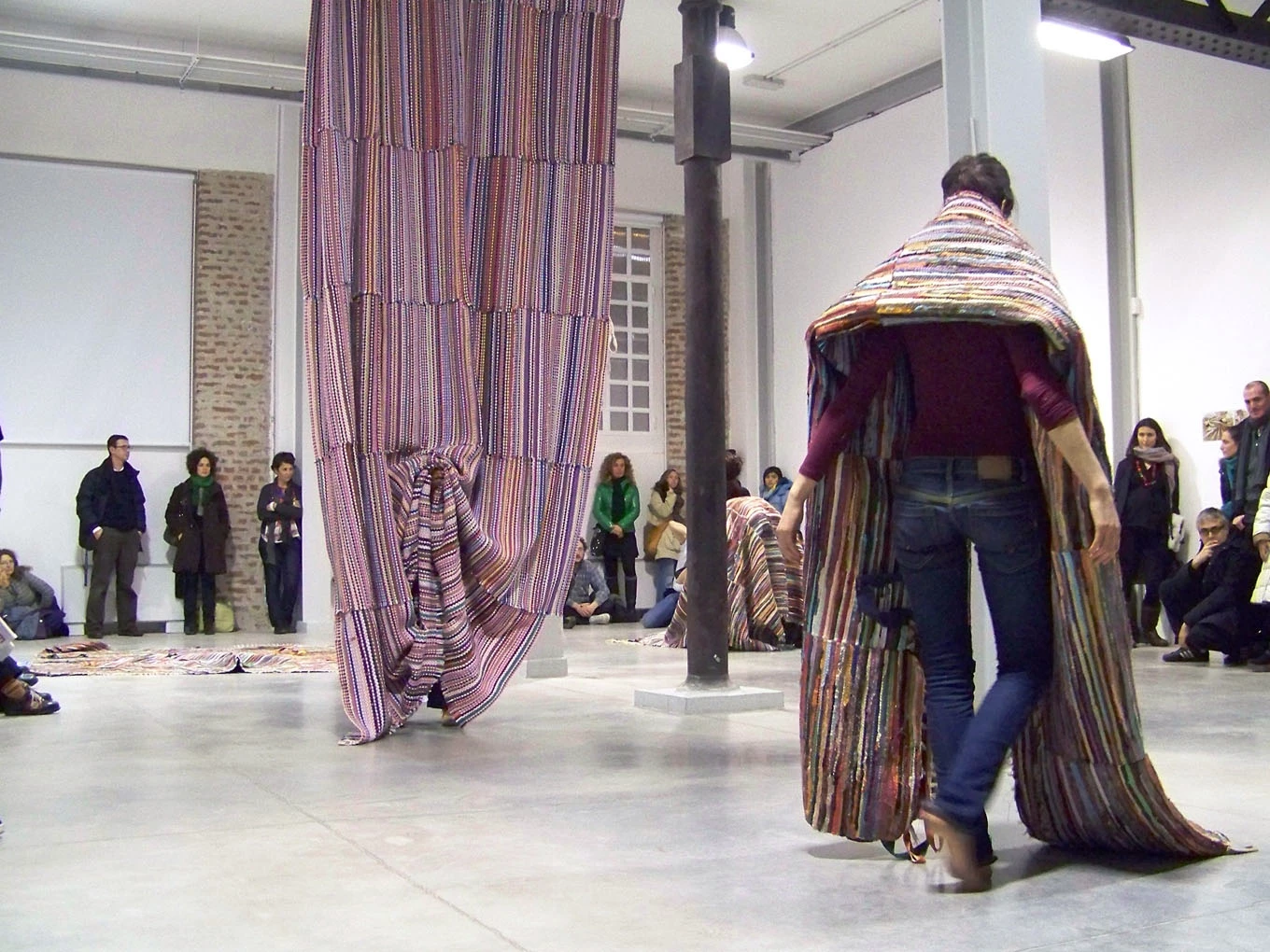Paola Anzichè • Tapis-à-porter
CURATED BY
Francesca Pasini
From 27.01 to 07.02.2009
On Tuesday, January 27, Careof presents a performance by Paola Anziché, concluding the workshop conducted by the artist with Cristina Crippa, Cristina Conoci, Ivana Messina, and Macella Panascì.
“Il tappeto offre un piano di lavoro dinamico e concreto. Può rappresentare un pavimento mobile, trasformabile, in grado di creare diverse forme di spazio sia orizzontali che verticali. Evidenzia una possibile linea di separazione, ma anche di relazione, fra noi e il suolo, e soprattutto fra noi e l'ambiente circostante. In quanto porzione delimitata di spazio, il tappeto diventa metafora concreta dell'idea di territorio, nonché simbolo del viaggio, della transizione e del nomadismo. Ecco emergere le sue molte funzioni: lo si veste, lo si usa come protezione e come costruzione leggera e temporanea”. (Paola Anziché)
During the performance, the dancers will “wear” several rugs – creations by the artist – generating multiple geometries and a dialogue between their bodies and the objects. In the following days, the exhibition space will host an installation composed of four rugs, sixty photographs, and documentation of the performances Flash out (2008), The functional fake objects (2007), Scatole (2007).
With the contribution of Fondazione Cariplo.
critical essay
By Francesca Pasini
There is always an involvement between the observer and the things observed, and very often it is not easy to recognize the point that determines the perspectival dimension of an action. Paola Anziché works on this edge, staging performances where dancers or gymnasts construct various perspectives by lifting and supporting with their bodies different elements: apples, books, fragments of a dismantled chair.
Paola intervenes by entering the scene and placing these elements on the dancers’ bodies, who with rhythmic movements cause them to fall, resetting the scene, which then recomposes itself with other movements and other figures. Paola’s presence in these mobile and momentary theaters signals the perspectival distance between the observer and the performer, between the objects in their moment of inertia and the one in which they reach the necessary balance for the image to form and dissolve. While watching the performances, we automatically enter the scene and, just like in theater, there are multiple points of view to coordinate, giving us the sense of participating in the conceptual design that precedes the visual configuration. The mobility of vision and the constant involvement between the observer and the things that manifest become apparent.
This empathy is made particularly explicit by the presence of the artist herself who, though measured and elusive, emphasizes the movement toward and into the scene that each of us undertakes.
In the video recordings that Paola also produces to study movements and frame them from precise perspectives, a shift occurs: the distance from the objects becomes visible, and each person identifies the rhythmic coordination that guides these “living theaters.” It is a very interesting transition that, on one hand, makes us understand the perceptive movement of reality, and on the other, stages the necessary decision for an image to take on that specific form and not another. The etymology of the word decision comes from the Latin de-caedere, which means “to cut,” and in her performances there is always a moment in which things break, fall, cut through the composition. Moreover, in these video documentations, the “textual outline” that underpins the performance appears, which in turn makes the documentation an autonomous visual and perspectival text and not merely a system for remembering what took place.
In the performance Tapis-à-porter, the object taken as text carries connotations that involve a particular architectural idea. The carpet is in itself a metaphor of a text where the warp and weft create an interweaving (textum), which in its variant tectum acquires the meaning of roof. Textual and architectural construction thus find a kinship that serves as a metaphor for human dwelling, made up of words, thoughts, houses, ground, and sky. The carpet is on one hand an ornament, on the other a protection, exactly like the words woven into a text, the threads composing the warp and weft, the beams and tiles used to build the roof.
From the performance Tapis-à-porter emerges the vision of an organic architecture represented by the carpet, the symbolic object of one of humanity’s primary productions: weaving. The fact that Paola arranges a device whereby gymnasts use it, wear it, move it, highlights a still little explored but very necessary need: to begin thinking of architecture as a gesture that intervenes in the overcrowding of objects, buildings, machines, activating processes of de-construction, suggesting practices that liberate territory, that cut through the excess of objects in favor of activities capable of establishing a different system of relations between bodies and the perspectives in which human actions take place.
This is not about returning to some mythical origin of huts, but rather to a condition where, instead of adding objects, one can replace the treadmill of incessant production with the idea of tapis-à-porter, in which everyone can identify their “personal” and collective perspective, where the objects necessary for life relate to those who use them and, in excess, can be imagined as wearable elements and therefore inseparable from one’s own body.
It does not concern a mere reduction in consumption, but a different concept of resource use and of the objects that have radically altered daily life, albeit in a very uneven way with respect to the distribution of the world’s inhabitants. For this to happen, good intentions or actual moments of crisis like the absence of oil are not enough—wide-ranging inventions are needed, even in art. Paola Anziché offers us the metaphor of a carpet that has no magical properties, but which, in recalling the nomadic attitude rooted in the history of civilizations, proposes a thought (textum) and an architecture (tectum) that aim to cut away objects destined to become obsolete and that overcrowd the world’s surface unsustainably.
(January 2009)
Bio
Paola Anzichè (1975 Milano). Lives and works in Torino. Graduated in 2004 at Städelschule, Staatliche Hochschule für Bildende Künste, Francoforte/Meno (classe Tobias Rehberger).
Selected solo shows. 2009: Tapis- à- porter, Careof, Milano. 2007: The functional fake objects, Placentia Arte, Piacenza; Functional fake, Agentur/outLINE, Amsterdam; Chinoserie, Istituto Italiano di Cultura, Belgrado. 2003: Video presentation, Museum Abteiberg, Moenchengladbach.
Selected group shows 2009: Avicenne, Glassbox, Cité Internationale Universitaire, Parigi. 2008: Mostra di fine corso Fondazione Spinola Banna Poirino, Torino; Proposte22, Accademia Albertina, Torino; It Takes Something to Make Something, Portikus, Francoforte/Meno. 2006: Labyrin, Botkyrka Konsthall, Stoccolma; Chinoiserie, Medien-kunstverein HMKV, Dortmund. 2004: The Galileo Studio, Kunsthaus Kloster Gravenhorst, Steinfurt. Abschluss-Ausstellung, Städelmuseum, Francoforte/Meno. 2003: Schau Raum, Stadthausgalerie, Münster. Gasthof, Städelschule, Frankfurt/Main. 2001: KlasseChrista Näher, Kunstverein, Francoforte/Meno.
Residenze. 2008: Dena Foundation for Contemporary Art al Centre International d’Accueil et d’Echanges des Recollets, Parigi (Città di Torino, UniCredit Private Banking, Fondazione Spinola Banna).
Prizes. 2008: VideoIT, Artegiovane, Torino. 2004: Moving up Mobility, G.A.I. Milano.
